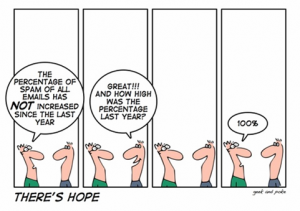(With a lot of credit to George Lenzer, blogger at alt.think!)
Here’s some facts about email’s biggest annoyance. Did you know:
- Spam is largely automated? There aren’t sweatshops full of people typing up those messages at lightning speed in some less developed nation for half a cent per day. In fact, the automation of spam is one aspect of it that makes it so difficult to combat.
- Your own PC might be a spam bot? Just as with medical conditions, I’ll leave the diagnosis of your PC being a spam bot to your chosen expert analyst, however… It’s quite easy to have your PC sending out tons of spam without you knowing it. Especially now that the typical desktop PC has 1980s super computer power ten times over and a fairly fast internet connection. You may not even notice a slowdown at all. Make sure you keep those OS updates and anti-virus/anti-malware signatures up to date. Also make sure you keep all of your networked software up to date too. That includes broswers, browser plug-ins, things like Java and Flash, IM clients, mail clients, etc…
- Spam can’t be traced back to it’s original source no matter what some movies and TV shows illustrate? In technical terms there is something of a list of routes that tells you where spam came from included in the message. This is known as a mail header and generally says, “The message arrived at your address from the address listed below. The message arrived to that address from the address listed below that. The message arrived to that address from the address listed below that”… But even if you go back to the first address in the list, it is likely that even that address was just someone’s home PC being controlled remotely by a spammer. So it’s a dead end. There is no way for an end user, or even a network administrator to track the message back to the accountable party and then file charges at them.
- Personal home computers infected with worms and viruses can generate spam on their own without a spammer controlling the system? Not necessarily spam that is useful to anyone, but the cryptic sort where you see excerpts of various mail messages spliced together. These systems also splice together the prefix and the domain of an e-mail address (the parts before and after the @ sign, respectively) in order to come up with new addresses to send to. Sometimes those messages actually hit a real person. And worst of all, these infected machines will use all of the e-mail addresses they have access to as the FROM address. This means that for all of the non-existent addresses that are created by this random patter, the unfortunate person being spoofed in the FROM field will get “scatterback” non-delivery messages. This usually makes people worry that they’ve been infected when they haven’t.
- Spammers, through the resource of these compromised “bot nets” have the ability to overload entire networks for purposes other than spam? The bot nets are used for more than just sending spam. In the past few years incidences of extortion on high profile sites have occurred. One party threatens another party who absolutely must remain online to be profitable with an attack that will knock them off the internet. That is unless they pay the requested sum of money.
Spam is a huge problem, and one that will not be easily solved. Mail administrators, like George, are constantly trying new tweaks or methodologies to lessen the amount of spam in your inbox…but the chances of them being completely successful are very low. It’s too easy for spammers to deluge mail systems with garbage, too fast. The next time you get a spam message in your email, be thankful you’re not seeing the other 95% of them that your mail admin helped to prevent. Over 100 billion spam messages are sent per day.
What does this mean to me, Laura?
- Be thankful for all of the spam you’re NOT getting.
- Keep your virus, anti-spyware and operating system up to date so that your PC does not become an infected zombie machine.
- Spam isn’t going away any time soon. It will only get worse.
- Bring your mail admin some cookies. Really.

We used to worry so much about things like putting email addresses on web pages without some way to obscure them from email address-scraping robots. Nowadays it seems like, what’s the point? You’ll never avoid getting spam either way.
RE: Owen
I think the problem with think that you’ll never avoid spam is that in most cases people aren’t aware of just how much spam they aren’t getting, as long as their IT people are doing something to filter it out.
Where I work, the spam filtering system cuts out 95 to 97 percent of all mail that comes into our network. Only 3 to 5 percent of the total mail stream makes it to users. Some of it is tagged as potential spam, the rest is mostly legit. The few bits of spam that do slip through make up a fraction of a percent of the total mail stream. This means that the spam filtering systems, the e-mail best practices, and so on, are all working as well as they can. It could be a lot worse if those steps weren’t taken to cut down on spam. So the minimal annoyance of a few messages per day should not invalidate the methods people use to try and cut down on spam.